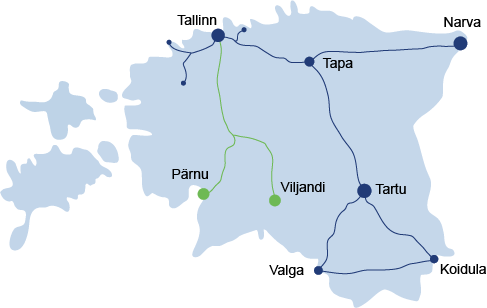The Competition Authority is developing measures to eliminate discriminatory or otherwise unfair treatment in the rail services market. It is also one of the important tasks of the Competition Authority to deal with complaints made by railway undertakings. If a railway undertaking considers that it has been unfairly treated by the infrastructure manager when approving a railway network statement, allocating capacity, organising coordination proceedings, declaring a capacity exhausted, drawing up a traffic schedule, organising traffic management, planning upgrades, carrying out maintenance work, or setting a user fee, it may lodge a complaint with the Estonian Competition Authority.
In Estonia, there are infrastructure managers i.e. AS Eesti Raudtee and Edelaraudtee Infrastruktuuri AS, the railways managed by whom are designated for public use. AS Eesti Raudtee manages 1,229 km of railways and provides the service of giving railway infrastructure into use to railway undertakings and rolling stock owners, together with traffic management. Edelaraudtee AS manages 222.1 km of railways, providing similar services

Joonis. AS Eesti Raudtee marked with blue and Edelaraudtee Infrastruktuuri AS with green on the Figure.
The competent authority for passenger transport organised in railway traffic is the Ministry of Economic Affairs and Communications and for the transport of passengers within a rural municipality or city, a local government may also be involved. Ministry of Economic Affairs and Communications has entered into a public service framework agreement for the years of 2018–2022 with AS Eesti Liinirongid (according to the company’s trademark Elron) to the extent of the entire volume of public passenger transport in Estonia. On the international passenger train line Tallinn-St. Petersburg-Moscow, AS GoRail carried out passenger transport; the company also sells tickets for all passenger trains to the Baltic States, the CIS countries and the countries in connection with them, including onward journeys between Finland and Russia.
As of 2021, thirteen undertakings held operating licences for rail transport of goods, but the majority of them were restricted to non-public railways, i.e. local transport of goods (e.g. ports and mines). The largest company operating on public railways was AS Operail.
According to Statistics Estonia, there were just over six million rail passengers last year. The number of passengers increased by 2% compared to 2020. Last year, the number of train passengers continued to be affected by the spread of the coronavirus. More than 500,000 journeys by rail were made each month between May and October, but fewer in the other months. Although the number of passengers increased year-on-year, it was more than a quarter lower than in 2019. While at the beginning of 2020, there was still a train service to Russia, then in 2021, it was not possible to organise international travels. Passenger traffic was 290 million passenger-kilometres, 10% more than in 2020 but a quarter less than in 2019.
11.9 million tonnes of goods were transported by public rail, 6% more than in 2020 but 10% less than in 2019. Goods transported by public rail accounted for half of all goods transported by rail. Compared to 2020, freight transport by public rail increased from January to June, decreased from July to September and in the last months of November and December.
Transit goods accounted for the majority, or 80%, of goods transported by public railways, with 10% coming from abroad and 2% going abroad. Freight traffic on public rail was 1.85 billion tonne-kilometres, a fifth more than in 2020, but slightly less than in 2019(1).
It is also important to note that in connection with the construction of the Rail Baltica railway, which will connect Estonia with Central and Western Europe and neighbouring countries in the future, while in 2021, the construction of six railway infrastructures and preparations for the construction of terminals were started in Estonia as part of the Rail Baltica project, then in 2022, the construction of ten railway crossing facilities will start and the total investment for this year will reach nearly 70 million euros(2).
At the moment, there are no foreseeable changes to railway legislation concerning the tasks of the Competition Authority.
-------------------------
(1) https://www.stat.ee/et/uudised/vaikesest-kasvust-hoolimata-ei-joudnud-rongisoitjate-arv-kriisieelsele-tasemele
(2) https://rbestonia.ee/pressiteated/2022-aastal-jouavad-ehitusse-kumned-rail-baltica-rajatised/
